Kyoto: 50 Things to Do, Places to Visit, Hotels, and Travel Tips

This Kyoto guide features the best things to do and famous places to visit - from iconic locations such as Kinkakuji (Golden Pavilion) and Fushimi Inari Taisha Shrine to lesser-known destinations. Travel tips on navigating Kyoto's areas, day trips from Kyoto, and hotels are also included!
First Time in Kyoto? Travel Around by Area!
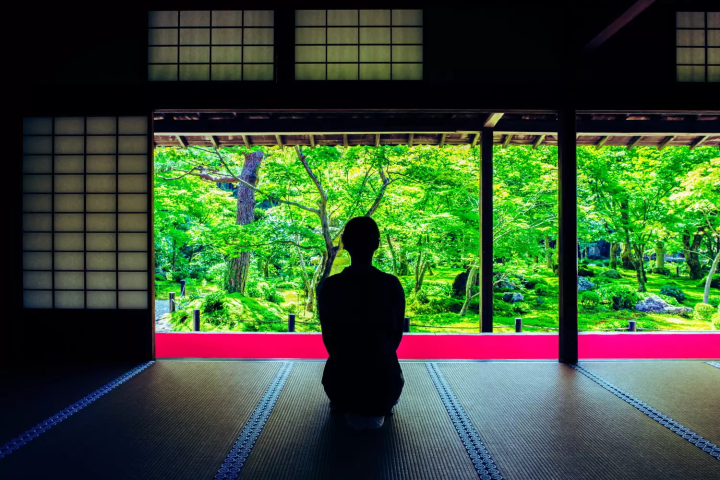
Photo by Pixta
Kyoto is a popular sightseeing destination among worldwide travelers. The city is filled with diverse charms from historical shrines and temples to photogenic landscapes and delicious Japanese cuisine.
It may be confusing to decide where to go first in Kyoto due to the multitude of famous places to visit.
Our suggestion is to decide on two or three main spots to visit and explore their neighboring areas. In this article, we’ve put together a guide for first-time visitors to Kyoto that introduces the best things to enjoy and places to visit alongside nearby attractions in the area!
Table of Contents
1. First Time in Kyoto? Travel Around by Area!
2. Recommended Spots in Kyoto City and Its Suburbs
The JR Kyoto Station Area
The Gion and Kiyomizudera Temple Area
The Heian Jingu Shrine Area
The Nijo Castle Area
The Arashiyama Area
The Fushimi Inari Shrine Area
The Kinkakuji Temple Area
The Shugakuin Imperial Villa Area
Kyoto City Suburbs and Neighboring Regions (Byodoin Temple, etc.)
3. Day Trips from Kyoto: Amanohashidate, Ine, and Others
4. Cherry Blossoms, Fall Foliage, and Events in Kyoto
5. Traveling to Kyoto
6. Ride Passes Available for Use in Kyoto
7. Kyoto Travel Tips and Precautions
Places to Visit in Kyoto City and Its Suburbs
Kyoto was the former capital of Japan from 794, established as Heiankyo at the time. The capital later moved in 1869 to Tokyo.
This city is an irresistible place to visit for history buffs. It has been witness to past Emperors, nobles, Oda Nobunaga—one of the most popular military leaders during the Sengoku Period—and the Shinsengumi during the Bakumatsu era. The city is also bursting with diverse sights and things to do, including markets with amazing food under one roof and a manga museum!
Next, we’ll introduce JR Kyoto Station. We’ll also dive into signature sightseeing spots such as Kiyomizudera Temple, Heian Shrine, Nijo Castle, Arashiyama, Fushimi Inari Shrine, Kinkakuji Temple, and Shugakuin Imperial Villa alongside other destinations in those areas.
The JR Kyoto Station Area
JR Kyoto Station is the starting point for your travels. Shopping spots like Bic Camera and AEON Mall are located within the station grounds or nearby, bringing liveliness to the area.
1. JR Kyoto Station
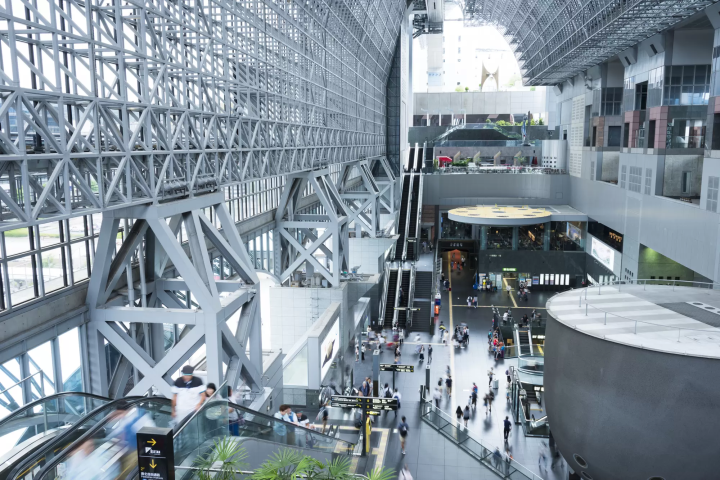
photo by Pixta
The Kyoto Station Building was designed by Hiroshi Hara, an architect involved in several projects such as the Umeda Sky Building in Osaka. The architecture of the building, purposely designed to emulate Heiankyo’s trademark grid pattern, is beautiful. There's even a walkway called the Sky Way where you can observe Kyoto’s streets from above.
Inside the station building, you’ll find various shopping facilities and eateries, including Kyoto Ramen Koji.
JR Kyoto Station
Address: Kyoto, Shimogyo, Karasuma-dori, Shiokoji-sagaru, Higashi-shiokojicho 901
Official Website: https://www.kyoto-station-building.co.jp/lp/english/
2. Kyoto Tower
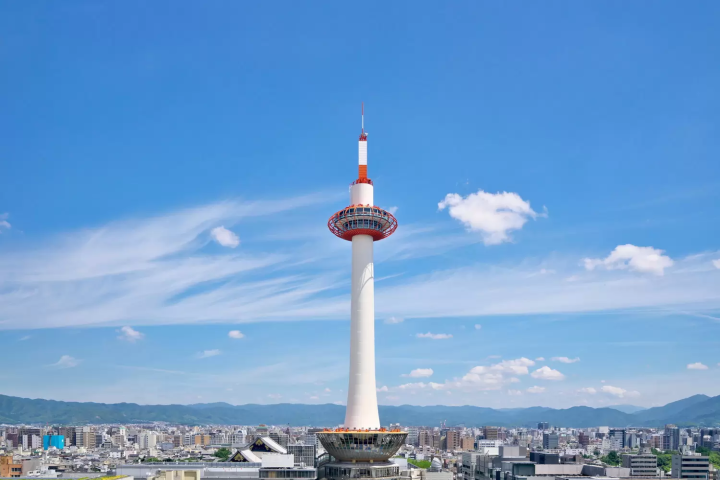
Photo by Pixta
Kyoto Tower opened in 1964 for the Tokyo Summer Olympics. The tower is the first in Japan to adopt a monocoque structure that combines cylindrical steel plates without the use of any steel frames.
There are restaurants inside the tower. You can also get a 360-degree view of downtown Kyoto from the observation deck, sitting 100 meters above ground. The unique illuminations at night are another highlight.
Kyoto Tower
Address: Kyoto, Shimokyo, Karasuma-dori, Shichijo-sagaru, Higashi-shiokojicho 721-1
Official Website: https://www.kyoto-tower.jp/en/
Purchase Kyoto Tower Observation Deck Admission Tickets!
3. Toji Temple

Picture from Kyoto’s Toji Temple: See the Magical Autumn Foliage at Night!
Toji Temple is the head temple of Shingon Buddhism and formerly entrusted to Kukai, also known as Kobo Daishi, by Emperor Saga in 796. It is the only remnant of Heiankyo that exists today. It’s also known as Kyoo Gokokuji Temple.
The entire temple grounds, centered around a figure of Dainichi Nyorai positioned in the Lecture Hall, is considered to be a mandala that represents the philosophy of esoteric Buddhism. It was registered as a World Heritage site in 1994 as part of the Historic Monuments of Ancient Kyoto.
Toji Temple
Address: Kyoto, Minami, Kujocho 1
Fee: 500 yen for adults
Official Website: https://toji.or.jp/en/index.html
4. Kyoto Railway Museum
The Kyoto Railway Museum is where visitors can immerse themselves in the history of railways. See exhibits and spend time in the experience corner by learning about Japanese history as it developed alongside railway systems. A total of 54 train carriages are on display, including those from steam locomotives and Shinkansen (bullet trains). You can even ride a passenger carriage pulled by an actual steam locomotive.
Kyoto Railway Museum
Address: Kyoto, Shimogyo, Kankijicho
Official Website: https://www.kyotorailwaymuseum.jp/en/
Purchase Kyoto Railway Museum Admission Tickets!
The Gion and Kiyomizudera Temple Area
The Gion and Kiyomizudera Temple area is a classic among classics as far as sightseeing spots in Kyoto go. There are also a considerable number of experiences where you can get a taste of Japan’s traditional culture by meeting a maiko (apprentice geisha) or trying your hand at wagashi (traditional Japanese confections).
5. Kiyomizudera Temple
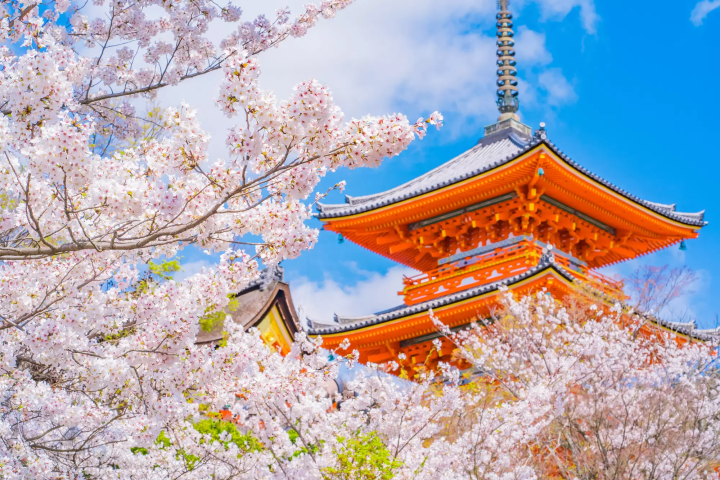
Photo by Pixta
Kiyomizudera Temple was established in 778. Its stage, which sits on a steep 13-meter slope, is particularly famous. The temple was built in an architectural style called kakezukuri and is purely constructed with wood without using a single nail.
There is a proverb still in use today that goes, “Jump off the stage of Kiyomizu." This translates to “take the plunge and act decisively,” inspired by the absolutely thrilling view from the temple.
Otowa Waterfall is a spring on the temple grounds believed to bring those who drink from it academic achievement, fulfillment of love, and longevity.
Kiyomizudera Temple
Address: Kyoto, Higashiyama, Kiyomizu 1-294
Official Website: https://www.kiyomizudera.or.jp/en/
6. Yasaka Shrine
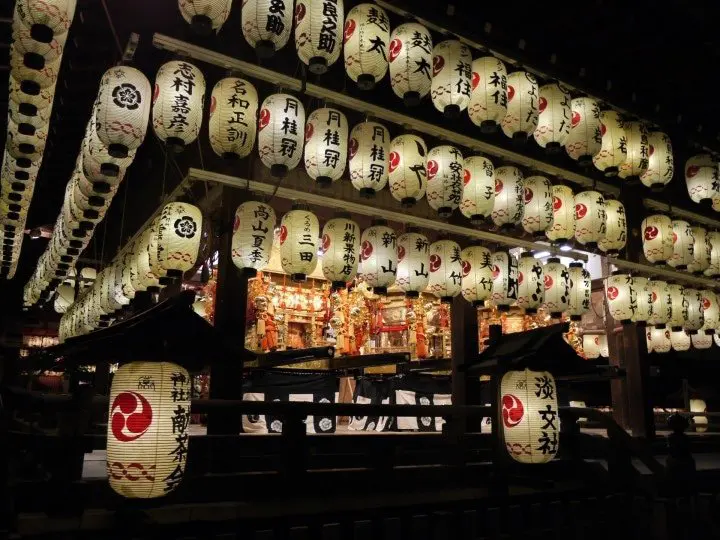
Yasaka Shrine is the central hub of the Gion Festival, one of three major festivals in Japan.
The shrine is a popular spiritual destination to pray for love. This is because this sacred spot is dedicated to Susanoo and Kushinadahime, a deity couple from Japanese mythology. The spring water at Utsukushigozensha, a small shrine on the grounds, is said to be blessed water that will work wonders on one’s beauty.
The shrine is believed to have been founded between the seventh to the ninth century. The vermillion main shrine is built in a special style called Gion-zukuri and is a designated national treasure.
Yasaka Shrine
Address: Kyoto, Higashiyama, Gionmachi, Kitagawa 625
Official Website: https://www.yasaka-jinja.or.jp/en/
Read also
7. Ninenzaka and Sannenzaka Hills
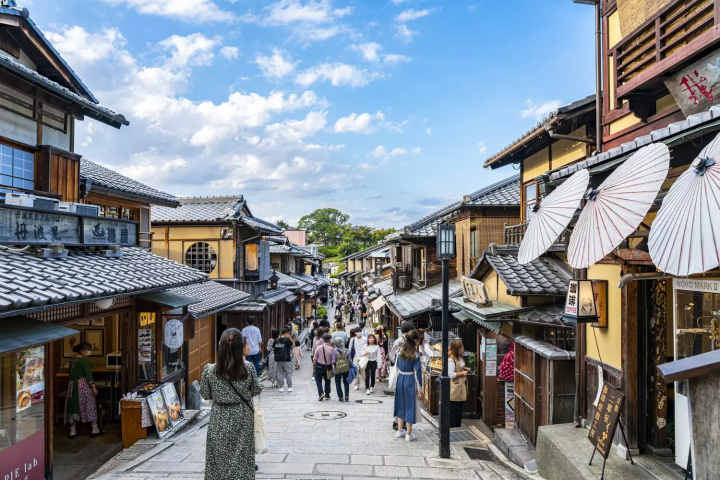
Photo by Pixta
Ninenzaka and Sannenzaka have flourished since ancient times as sloping streets leading to Kiyomizudera Temple. These two streets, flanked by rows of traditional buildings, are a signature sight of Kyoto. You can delight in several restaurants and souvenir shops here.
Sannenzaka
Google Maps: https://goo.gl/maps/2tvCVRgBZN7iS2f8A
8. Gion (Hanamikoji Street, etc.)
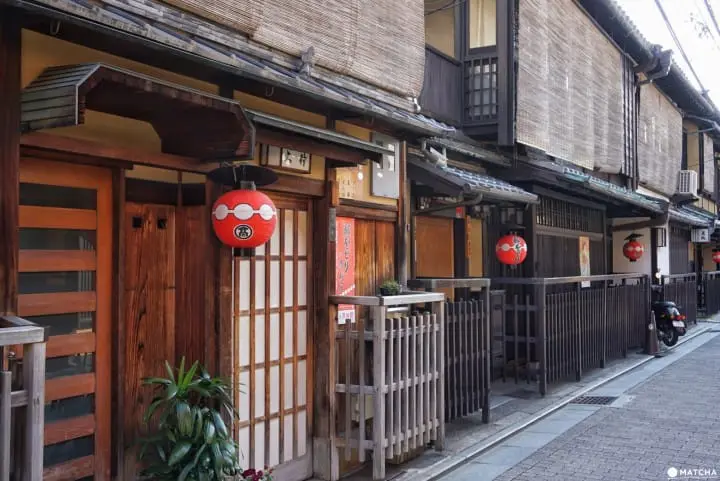
Picture from Kyoto’s Gion Area - A Walking Tour
Gion is an entertainment district located near Yasaka Shrine. It is famous for tea houses that entertain customers with maiko (apprentice geisha).
The main street in Gion is called Hanamikoji Street where you’ll find stores selling traditional crafts and cafes. The atmosphere, which closely resembles the old capital, captivates both domestic and international travelers visiting the district.
Hanamikoji Street
Google Maps: https://goo.gl/maps/1zY3LFfd8cK4Egcs9
Kagai Experience Tour with Kyoto Maiko Dance and Kaiseki Lunch
9. Maruyama Park

Photo by Pixta
Maruyama Park (Japanese) is located adjacent to Yasaka Shrine. It is known as a famous cherry blossom spot, highlighted by a Japanese garden designed like a recreation of nature with a waterfall and pond.
Maruyama Park
Address: Kyoto, Higashiyama, Maruyamacho
Official Website: https://kyoto-maruyama-park.jp/ (Japanese)
The Heian Jingu Shrine Area
This area is slightly north of Yasaka Shrine and Kiyomizudera Temple. It is home to shrines and temples such as Heian Jingu Shrine and Ginkakuji Temple, while also being concentrated with art museums like the Kyoto City KYOCERA Museum of Art and The National Museum of Modern Art, Kyoto.
It’s recommended to travel around this area while paying a visit to the Kiyomizudera Temple area due to its proximity.
10. Heian Jingu Shrine
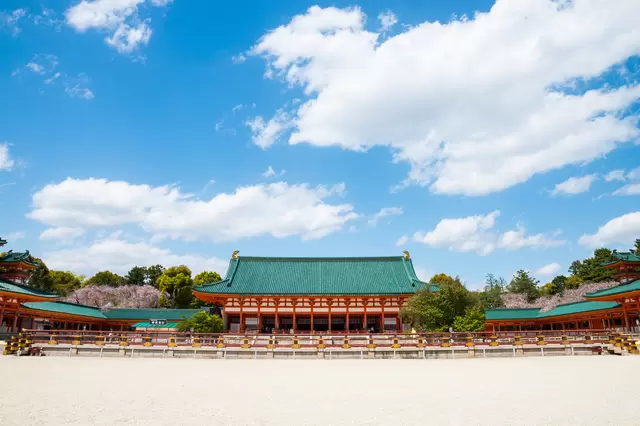
Heian Shrine was established in 1895 for the 1100th anniversary of the capital’s move to Heiankyo.
Kyoto at the time was in remarkable decline due to disorder during the Bakumatsu era and the relocation of the capital to Tokyo. This shrine was built during that time in an attempt to make Kyoto a vibrant city once more.
The highlight of this shrine is its vermillion main building modeled after the Chodoin, previously the center of government affairs in Heiankyo. It’s also a famous cherry blossom spot that was depicted in a famous novel by Junichiro Tanizaki titled The Makioka Sisters.
Heian Shrine
Address: Kyoto, Sakyo, Okazaki, Nishitennocho 97
Official Website: http://www.heianjingu.or.jp/english/english.html
11. Ginkakuji Temple
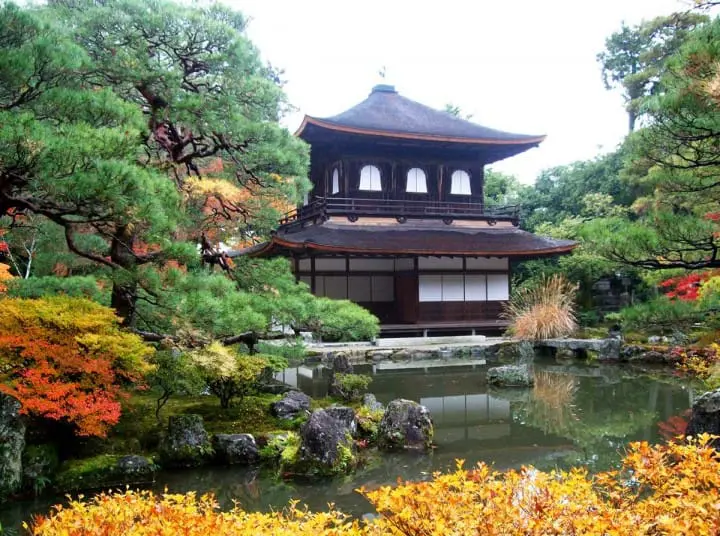
Picture from The Philosopher’s Walk In Kyoto - Enjoy It Every Season!
Ginkakuji Temple is formally known as Tozan Jishoji Temple. It was originally a mountain villa built by Ashikaga Yoshimasa, the eighth general of the Muromachi shogunate (1338-1573), and founded in 1490.
The Higashiyama culture is characterized by modest, sophisticated elegance. Moreover, it flourished due to influences from Ashikaga Yoshimasa’s reign, Chinese culture, and Zen Buddhism. Ginkakuji Temple has an architecture that is characteristic of the Higashiyama culture.
Ginkakuji Temple
Address: Kyoto, Sakyo, Ginkakujicho 2
Official Website: https://www.shokoku-ji.jp/en/ginkakuji/
12. Eikando Temple
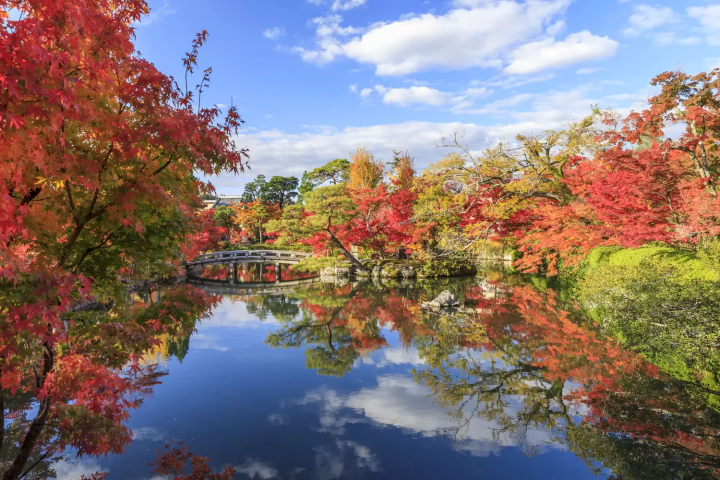
Photo by Pixta
Eikando Temple was built in 863. Its formal name is Zenrinji Temple, but became known as Eikando Temple due to its association with Yokan Risshi. He was the chief monk between the 11th to 12th century who focused on relief efforts for those in poverty.
It is a famous autumn foliage spot that appears in Kokin Wakashu: The First Imperial Anthology of Japanese Poetry. The temple is also illuminated at night (Japanese).
The principal object of worship is the Mikaeri Amida Nyorai (Amitabha Looking Back). Buddhist statues normally face forward, but this figure of Amitabha tilts his head to the side as if he were looking back. This entrancing statue almost appears as if he is addressing you in a gentle tone.
Eikando Temple
Address: Kyoto, Sakyo, Eikandocho 48
Fee: 600 yen for adults
Official Website: http://www.eikando.or.jp/English/index_eng.html
13. Nanzenji Temple
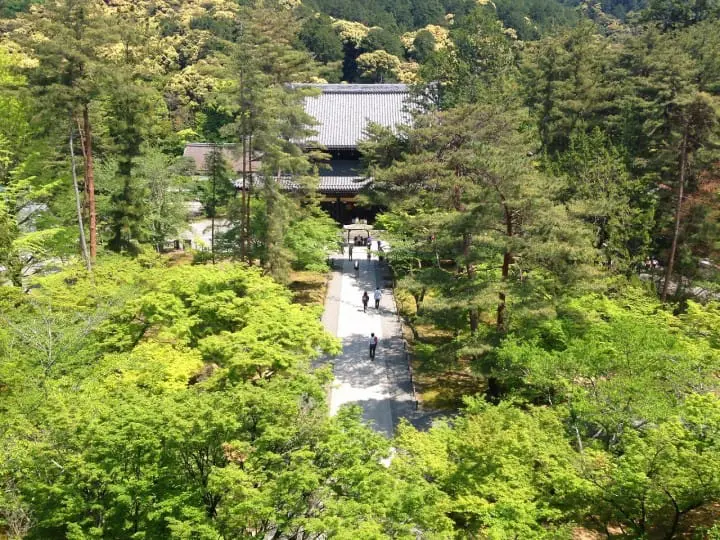
Nanzenji Temple (Japanese) is the head temple of the Rinzai School of Zen Buddhism. It is a famous place for cherry blossoms in the spring and fall foliage in the autumn. People visit the temple in droves during these seasons.
The Sanmon Gate is a splendid gate located on the temple grounds. It is also home to Hojo Garden, a karesansui-style garden, and Nanzenin Temple, selected among the three National Sites and Places of Scenic Beauty in Kyoto.
Nanzenji Temple
Address: Kyoto, Sakyo, Nanzenji, Fukuchicho
Fee: 600 yen for adults for the Sanmon Gate, Hojo Garden, and Nanzenin Temple
Official Website: https://www.nanzenji.or.jp/ (Japanese)
14. Philosopher’s Path
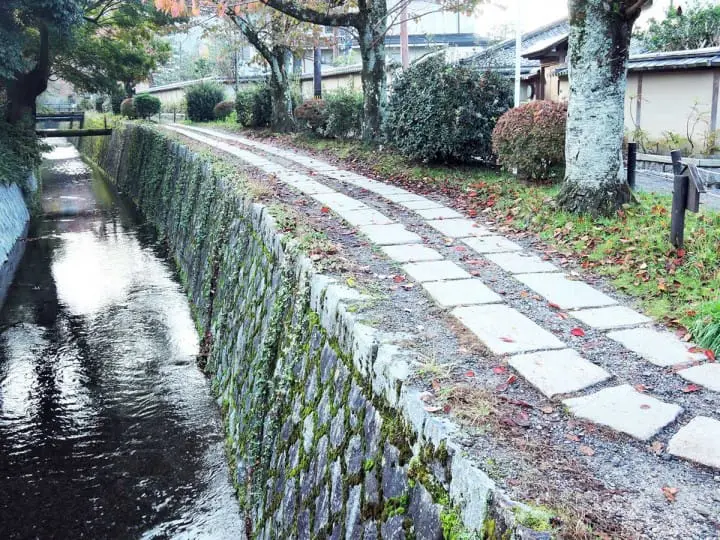
Picture from The Philosopher’s Walk In Kyoto - Enjoy It Every Season!
The Philosopher’s Path (Japanese) is the name of the two-kilometer pathway between Ginkakuji Temple and Nanzenji Temple. The name originated from its connection with Kitaro Nishida (1870-1945), a philosopher, who would walk this pathway every morning and engross himself in his thoughts.
Kitaro Nishida was the founder of a unique philosophy that combined Zen Buddhism with Western philosophy. He is also a highly regarded figure worldwide.
The Philosopher’s Path is a famous place for cherry blossoms and autumn foliage. The canal is adorned with cherry blossoms and autumn foliage come their respective seasons.
The Philosopher’s Path
Google Maps: https://goo.gl/maps/gN4PaxfPGTEdM3hM9
15. Kyoto City KYOCERA Museum of Art
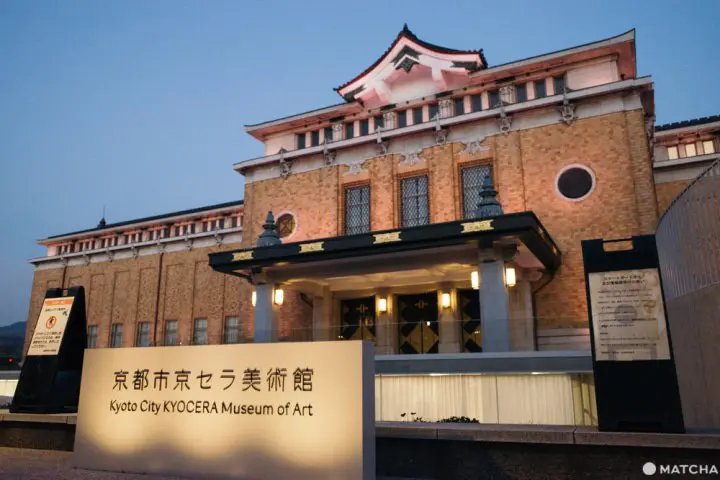
Kyoto City KYOCERA Museum of Art, right next to Heian Jingu Shrine, is familiar to many people under its original name Kyoto City Museum of Art. The Japanese-Western architecture built in 1933 is one of the oldest public art museums in Japan.
The museum reopened as the Kyoto City KYOCERA Museum of Art in 2020 thanks to renovations helmed by architects Jun Aoki and Tezzo Nishizawa. Museum-goers can enjoy various exhibits in a gorgeous space blending modern charms with great features preserved from the old building.
Kyoto City KYOCERA Museum of Art
Address: Kyoto, Sakyo, Okazaki Enshojicho 124
Fee: 730 yen
Official Website: https://kyotocity-kyocera.museum/en/
16. Hosomi Museum
Hosomi Museum is an art museum displaying a collection from the industrialist Hosomi family. The museum’s highlights are exhibits that encompass several fields and eras in Japanese art. This includes art found in Shintoism, Buddhism, tea ceremonies, and paintings dating from the Edo Period.
Hosomi Museum
Address: Kyoto, Sakyo, Okazaki Saishojicho 6-3
Fee: Varies based on the exhibition
Official Website: http://www.emuseum.or.jp/eng/index.html
The Nijo Castle Area
Near Nijojo-mae Station and Karasuma Oike Station along the subway are an array of unique spots. Some include Nijo Castle, an important historical landmark, Shinkyogoku Shopping Street, and the Kyoto International Manga Museum.
17. Nijo Castle

Photo by Pixta
Nijo Castle is famous as the location of the Imperial rule’s restoration—a declaration that the Edo shogunate would return political power to the Emperor—that occurred in 1867. It was the stage for a major turning point in history as Japan transitioned into the Meiji Period.
Nijo Castle was originally built in 1603 by Tokugawa Ieyasu, the first general of the Edo shogunate. It underwent large-scale repairs during the time of Tokugawa Iemitsu, the third general. Today, there are many things you can admire and enjoy in the castle such as architecture that expresses its brilliant history and gorgeous decorations.
Nijo Castle
Address: Kyoto, Nakagyo, Nijojocho 541
Fee: 800 yen (1,300 yen if Ninomaru Palace is included)
Official Website: https://nijo-jocastle.city.kyoto.lg.jp/?lang=en
Purchase Nijo Castle Admission Tickets
18. Nishiki Market
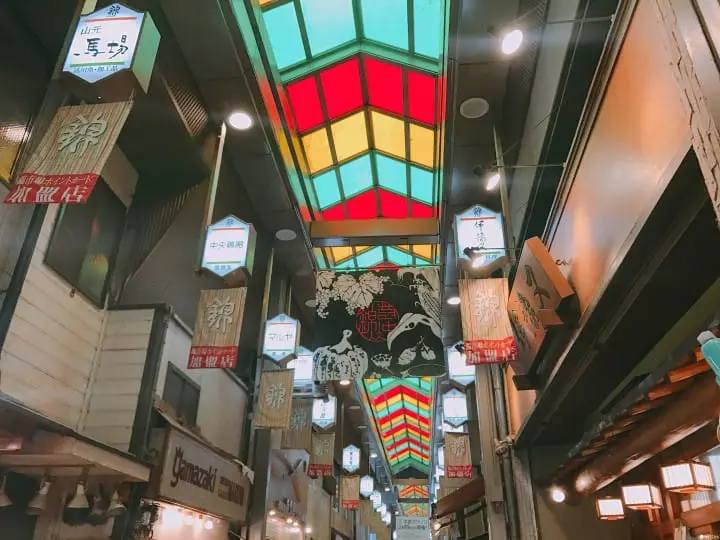
Picture from Top 7 Dishes to Try at Nishiki Market in Kyoto!
Nishiki Market has been in business since the days of old in Kyoto. Records of the market are said to have existed since around the Heian period and was officially recognized by the Edo shogunate in 1615.
Nishiki Market is called “the kitchen of Kyoto.” This nickname came about because various ingredients particular to Kyoto have converged in this one place for hundreds of years. You can still enjoy an array of high-quality foods today.
Nishiki Market
Google Maps: https://goo.gl/maps/YUzrmnY5iJCTpdGV6
19. Kyoto International Manga Museum
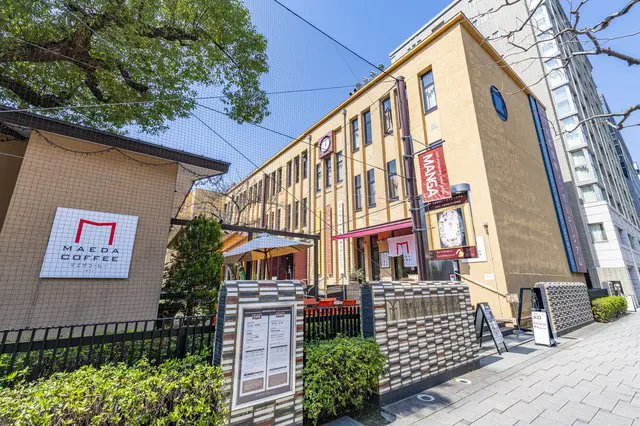
Photo by Pixta
The Kyoto International Manga Museum was established in joint collaboration by Kyoto City and Kyoto Seika University. It is Japan’s first manga museum.
The museum maintains a collection of 300,000 manga materials. This ranges from ukiyo-e (woodblock prints) from the Edo Period (1603-1868), magazines dating to the Meiji (1868-1912), Taisho (1912-1926), and early Showa (1926-1989) Periods, and rental books that saw popularity after World War II to popular modern manga series and even comic books from overseas.
You can not only enjoy reading a variety of manga genres but also attend manga-related workshops at the museum.
Kyoto International Manga Museum
Address: Kyoto, Nakagyo, Kinbukicho 452
Fee: 900 yen
Official Website: https://kyotomm.jp/en/
Purchase Kyoto International Manga Museum Admission Tickets
20. Honnoji Temple
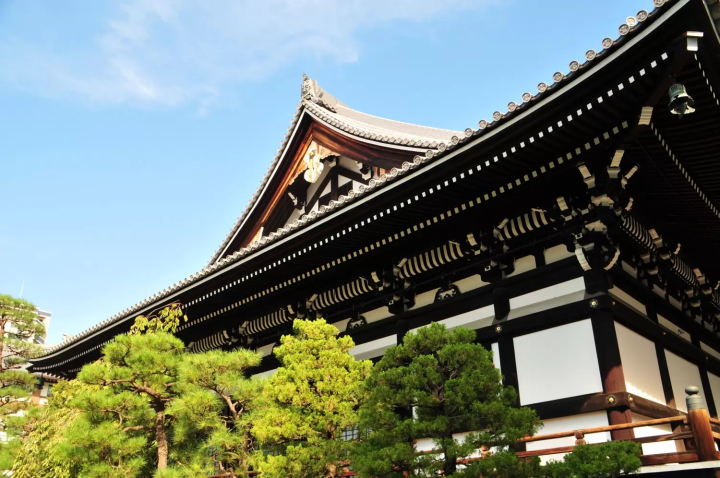
Photo by Pixta
“The enemy is in Honnoji Temple.” For history buffs, you should know these words very well. These were the words that Akechi Mitsuhide, a retainer, uttered upon his betrayal and attack on Honnoji Temple where Oda Nobunaga, an active figure during the Sengoku Period, rested.
Honnoji Temple is of the Hokke sect established in 1415. At the time of Nobunaga’s rule, the head of Honnoji Temple was Nissho Shonin who was a relative of the Emperor. Nobunaga, who desired to strengthen his connections with the Emperor, would stay at Honnoji Temple and requested to be taught the teachings of Buddhism by Nissho Shonin.
Today, you can view various exhibit items related to Oda Nobunaga as a place that was a turning point in history.
Honnoji Temple
Address: Kyoto, Nakagyo, Teramachi-dori, Oikesagaru, Shimohonnojimaecho 522
Official Website: https://www.kyoto-honnouji.jp/language.html
21. Shinkyogoku Shopping Street

Photo by Pixta
Shinkyogoku Shopping Street was a place where various temples congregated and festivals were held during the Edo Period. The street was developed during the Meiji Period. It has now become a place where theatrical performances are held with both sides of the arcade lined with restaurants.
Currently, it is a staple spot for shopping as a shopping street representative of Kyoto. You can enjoy various restaurants, a movie theater, and purchase commemorative souvenirs.
Shinkyogoku Shopping Street
Google Maps: https://goo.gl/maps/VcAKKG6YoWFnDAq67
22. Kyoto Samurai and Ninja Museum
The Kyoto Samurai and Ninja Museum is where you can admire historic armors and swords while learning about ninjas in Japanese history.
You can even wear costume armor and a helmet to take pictures. There are also ninja experiences like ninja star throwing.
Kyoto Samurai and Ninja Museum
Address: Kyoto, Nakakyo, Teramachi, Nishikikoji-sagaru Higashidaimonjicho 29
Official Website: https://mai-ko.com/jp/samurai/
The Arashiyama Area
Arashiyama, located a short distance away from urban Kyoto, flourished as the area of villas that belonged to nobles during the Heian Period. Currently, the area bustles with millions of visitors, especially during the autumn foliage season. It is hailed as one of Kyoto’s leading and most scenic spots.
23. Togetsukyo Bridge
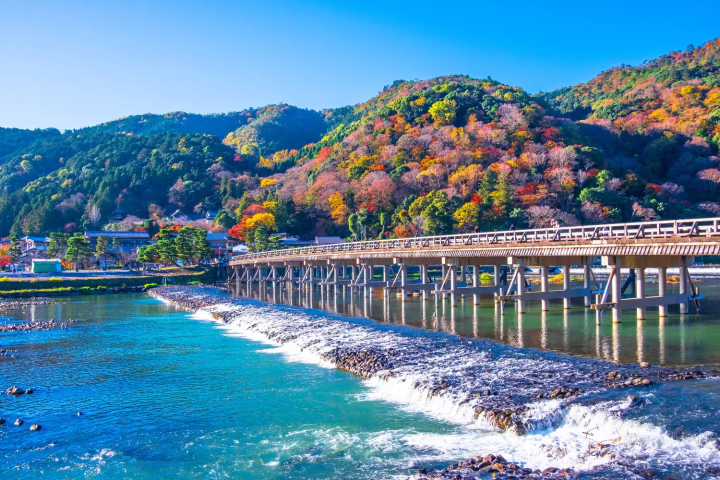
Photo by Pixta
Togetsukyo Bridge is one of Arashiyama’s leading scenic spots where you can experience Kyoto’s nature to the fullest. The original bridge was built in the ninth century. However, its present state is thanks to repairs and improvements made in 1934.
“Togetsu” means moon crossing. It came to have this name because Kameyama Joko (1249-1305*) thought “it appears as if the full moon is crossing (over the bridge)” as he gazed at the moon moving in the sky above.
Togetsukyo Bridge
Google Maps: https://goo.gl/maps/22fXW5KpeW183nQ78
*Joko: an honorary title given to an Emperor after his position is inherited by his successor.
Purchase Arashiyama Gourmet Coupon + Randen 1 Day Free Ticket
Get Fu Fu No Yu Onsen Admission Tickets in Kyoto
Book a Kyoto Arashiyama Rickshaw Tour
24. Tenryuji Temple
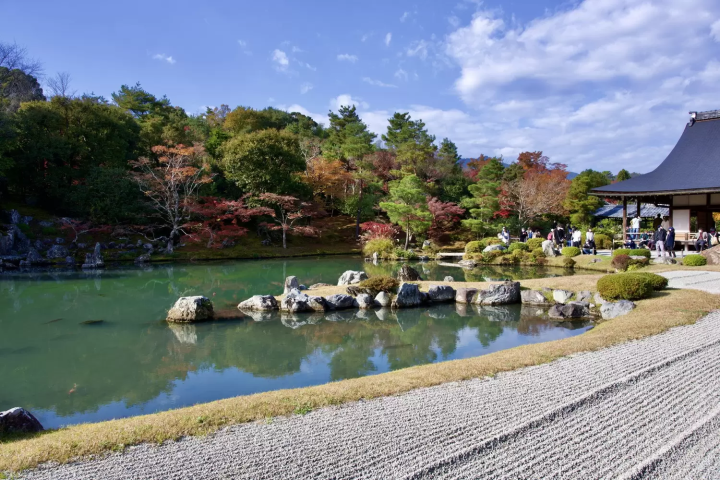
Photo by Pixta
Tenryuji Temple is a Zen temple of the Rinzai sect that was established by Ashikaga Takauji in 1339. Sogenchi Pond Garden, designed by a Zen monk by the name of Muso Soseki, is a Japanese garden masterpiece and a registered World Heritage site.
The Cloud Dragon Painting on the ceiling of Hatto is a compelling artwork that “glares in all directions.” No matter where you view it, the dragon appears as if he is glaring back at you. Due to severe damage, this painting can only be seen on weekends, national holidays, and special temple visits as of April 2023.
Tenryuji Temple
Address: Kyoto, Ukyo, Saga-Tenryuji, Susukinobabacho 68
Fee: Garden 500 yen, Shodo 300 yen, Hatto 500 yen
Official Website: https://www.tenryuji.com/en/
25. Saihoji Temple (Kokedera): The Moss Temple
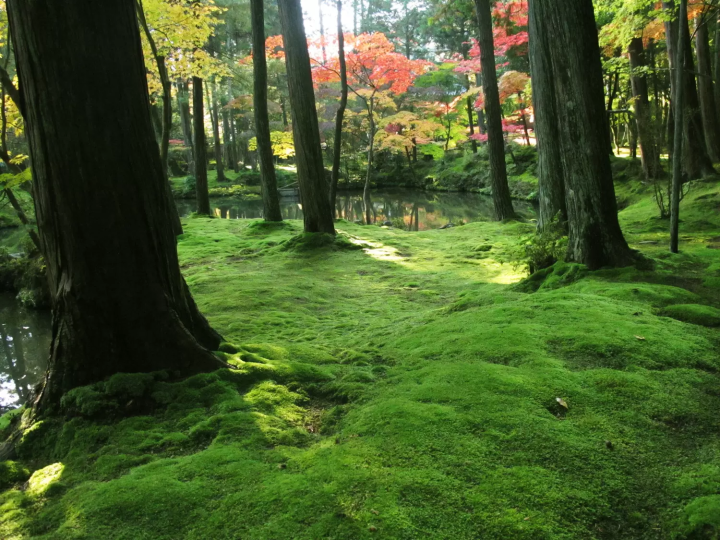
Photo by Pixta
Saihoji Temple (Japanese) is a Zen temple founded in 731. It is also registered as a UNESCO World Heritage site.
The garden, measuring nearly 35,000 square meters in size, has many highlights for visitors to see. It’s also known as Kokedera (“koke” meaning moss) due to its exceptionally beautiful landscape with over 120 moss species.
Saihoji Temple
Address: Kyoto, Nishikyo, Matsuojingatanicho 56
Fee: Over 3,000 yen (advanced reservations required)
Official Website: http://saihoji-kokedera.com/top.html (Japanese)
26. Arashiyama Bamboo Grove

Picture from Arashiyama, Kyoto - Top Things To Do, Travel Tips, And Transportation
The Arashiyama Bamboo Grove (Japanese) is a pathway approximately 400 meters in length. It begins from Nonomiya Shrine, goes through the north gates of Tenryuji Temple, and exits out to Okochi Sanso.
This picturesque spot in Arashiyama rivals that of Togetsukyo Bridge with beautiful sunlight filtering through the bamboo trees. You’ll run into many kimono-clad people to take pictures.
Arashiyama Bamboo Grove
Google Maps: https://goo.gl/maps/FCX3AXuf1eEtvytEA
27. Toei Kyoto Studio Park
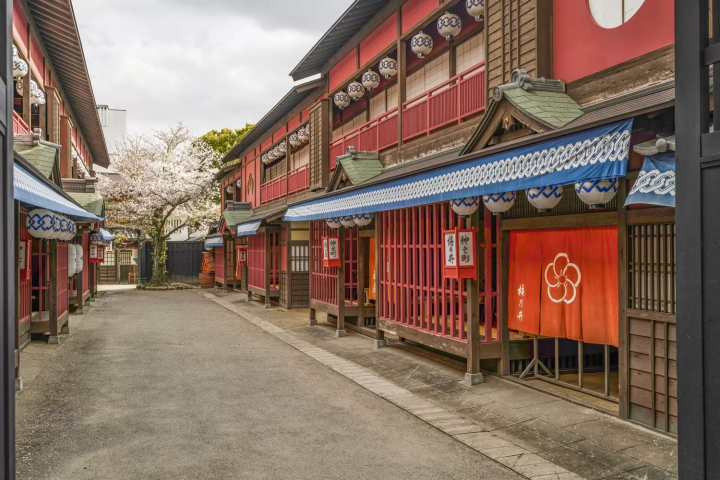
Photo by Pixta
The Toei Kyoto Studio Park, accessible in about 20 minutes by train from Arashiyama Station on the Randen (Keifuku Electric Railroad), is a movie theme park that has opened sets used by film studios to the public.
The park has recreated the streets of Edo and regularly holds shows like sword fighting. There are also exhibitions and events for tokusatsu superhero series, including Kamen Rider or popular anime series like Pretty Cure. Theme park goers of all ages can enjoy this park!
Toei Kyoto Studio Park
Address: Kyoto, Ukyo, Uzumasa, Higashi-Hachiokacho 10
Fee: 2,400 yen
Official Website: https://global.toei-eigamura.com/
28. Koryuji Temple

Photo by Pixta
Koryuji Temple (Japanese), located near Toei Kyoto Studio Park, is Kyoto’s oldest temple. It is believed to have been established in 603. The temple is especially famous for the Wooden Statue of Maitreya Bodhisattva, the first designated National Treasure in Japan.
This Buddhist statue is equally famous as the Statue of Pensive Bodhisattva in Chuguji Temple, Nara. Both statues are prominent examples of the archaic smile (smiling only with slightly upturned corners of one’s mouth).
Koryuji Temple
Address: Kyoto, Ukyo, Uzumasa, Hachiokacho 32
Fee: 800 yen
Official Website: https://ja.kyoto.travel/tourism/single01.php?category_id=7&tourism_id=284 (Japanese)
The Fushimi Inari Shrine Area
The surrounding area of Shichijo Station and Fushimi-Inari Station on the Keihan Main Line, located east of JR Kyoto Station, is home to multiple sights to see. This includes Fushimi Inari Grand Shrine, which is popular worldwide. We recommend visiting the shrine together with JR Kyoto Station and Kiyomizu Temple due to its proximity.
29. Fushimi Inari Grand Shrine

Picture courtesy of Pixta
Fushimi Inari Grand Shrine is ever popular as one of Kyoto’s leading and most picturesque spots. It is the head shrine of 30,000 Inari Shrines across Japan. Inari is devoutly worshiped as the deity of prosperous businesses and bountiful harvests.
The Senbon Torii (“Thousand Torii Gates”) is especially popular at Fushimi Inari Shrine. Those who visited Fushimi Inari Shrine and had their wishes granted will observe a certain custom. This involves dedicating a torii gate to the shrine as an expression of gratitude.
This beautiful, majestic sight featuring 10,000 torii gates was constructed at the shrine after thousands of people dedicated a torii gate in their name.
Fushimi Inari Grand Shrine
Address: Kyoto, Fushimi, Fukakusa Yabunouchicho 68
Official Website: http://inari.jp/en/
Book a Fushimi Inari Taisha, Kiyomizudera Half-Day Tour in Kyoto
30. Tofukuji Temple
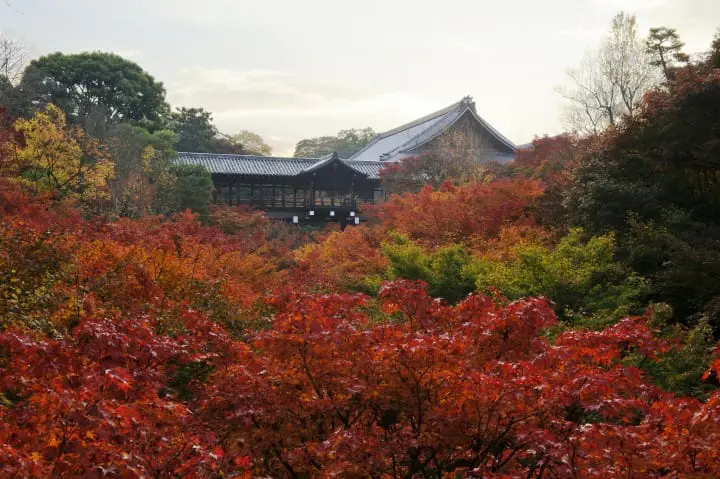
Picture courtesy of Tofukuji Temple, See Kyoto In Autumn - 11 Places To Visit For Foliage In 2021
Tofukuji Temple (Japanese) was constructed over 19 years from 1236 to 1255. It was built with the desire to model the temple after Todaiji Temple and Kohfukuji Temple, two temples that attained great influence in Nara.
It is known as Kyoto’s largest "garan" (a compound of buildings in a temple). Highlights include Hojo Garden, composed of four gardens with diverse charms, Tsutenkyo Bridge, which stretches over a valley, and more!
Tofukuji Temple
Address: Kyoto, Higashiyama, Honmachi 15-778
Fee: 1,000 yen
Official Website: https://tofukuji.jp/ (Japanese)
31. Sanjusangendo Temple
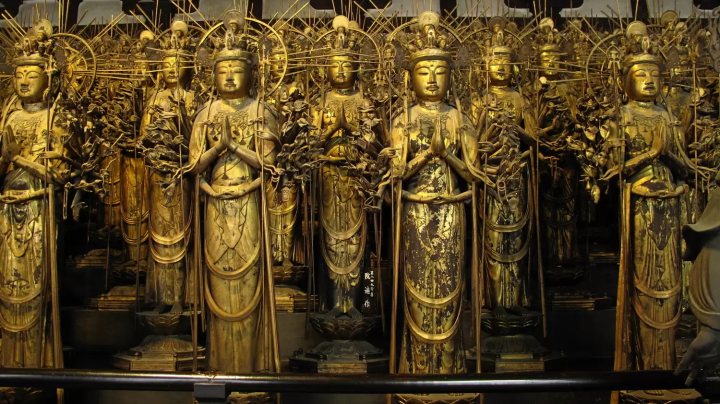
Photo by Pixta
Rengeoin Sanjusangendo Temple (Japanese) was originally constructed in the 12th century. However, it burnt down in a fire and was subsequently rebuilt in 1266.
The number “33” in its name refers to Kannon Bodhisattva transforming into 33 manifestations in order to save the people. There are 33 bays (the space between two pillars) in the temple.
Sanjusangendo Temple’s greatest highlight is the Thousand-Armed Kannon Statues. These 1,000 Kannon statues were made sometime between the Heian and Kamakura periods. The saying goes that there is “a statue that resembles the person you absolutely want to see” among these Kannon statues.
Sanjusangendo Temple
Address: Kyoto, Higashiyama, Sanjusangendomawaricho 657
Fee: 600 yen
Official Website: http://www.sanjusangendo.jp/ (Japanese)
32. Kyoto National Museum

The Kyoto National Museum was established in May 1897. It exhibits various cultural properties from Kyoto that date between the Heian and Edo periods.
Several of these cultural products are unique to Kyoto, including Buddhist statues, dyed goods, Japanese lacquer, and sutras inscribed with Buddhist texts. This makes the museum the perfect place for deepening your understanding of Japanese culture.
Kyoto National Museum
Address: Kyoto, Higashiyama, Chayacho 527
Fee: Fluctuates depending on the season
Official Website: https://www.kyohaku.go.jp/eng/
33. Teradaya
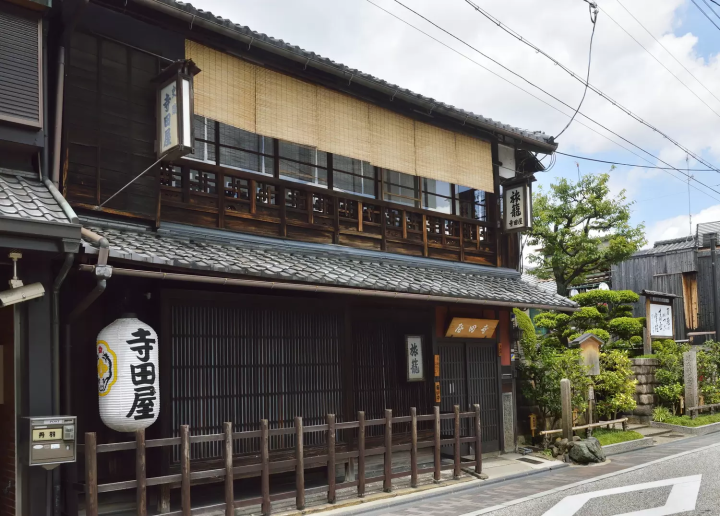
Photo by Pixta
If you're interested in the history of the shogunate, then you’ve probably heard of Teradaya (Japanese).
Teradaya is, as you may have guessed, where the Teradaya Incident took place in 1862. During this incident, royalists from the Satsuma domain, those who conspired to overthrow the shogunate and restore the Emperor’s power, were attacked at the inn. In 1866, an attack on Ryoma Sakamoto, a key figure in overthrowing the shogunate, also took place at the inn—making it an important setting in history.
The inn is quite far from Fushimi Inari Shrine and is about 30 minutes by train. However, please pay a visit if you’re interested in the history of the shogunate.
Teradaya
Address: Fushimi, Minamihamacho 263
Official Website: https://ja.kyoto.travel/tourism/single01.php?category_id=8&tourism_id=940 (Japanese)
The Kinkakuji Temple Area
There are many popular sightseeing spots in the area northwest of JR Kyoto Station. Some of them include Kinkakuji Temple, one of the signature tourist spots in Kyoto, and the World Heritage Ryoanji Temple.
34. Kinkakuji Temple (Golden Pavilion)

Kinkakuji Temple was established as a villa in 1397 by Ashikaga Yoshimitsu—the third general of the Muromachi shogunate. The interior and exterior of the Shariden, the three-storied pavilion and reliquary hall where Buddha’s ashes are enshrined, are completely covered in gold leaf. Visitors are enthralled at the sight of this beautiful golden shine.
During Ashikaga Yoshimitsu’s time, the Muromachi shogunate prospered in trade with China. This temple is where you can feel that historical influence.
Kinkakuji Temple was burned down in an arson incident in 1950 and was later reconstructed. The incident sparked the inspiration behind one of novelist Yukio Mishima’s best works "The Temple of the Golden Pavilion." The roof and gold leaf were most recently repaired and restored in 2020.
Kinkakuji Temple
Address: Kyoto, Kita, Kinkakujicho 1
Fee: 500 yen
Official Website: https://www.shokoku-ji.jp/en/kinkakuji/
35. Ryoanji Temple
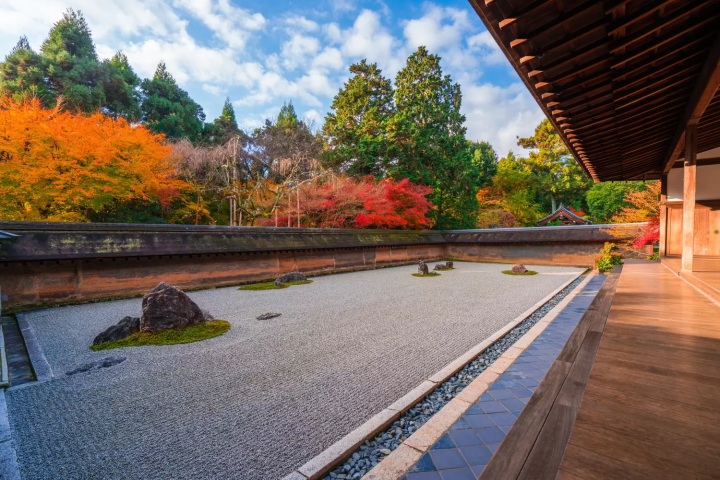
Photo by Pixta
Ryoanji Temple (Japanese) is most famous for its karesansui garden, exquisitely crafted with only rocks and white sand. It also gained international popularity after Queen Elizabeth II visited in 1975 and spoke highly of the temple.
While there are 15 rocks laid out in the garden, they are arranged so only 14 rocks are visible—regardless of what angle they are seen from.
In Asia, the number 15 is considered to be the perfect number. Moreover, deterioration is believed to begin from the moment an object reaches its complete state. This is considered the reason why the garden is intentionally designed so that only 14 rocks can be visible at all times.
Ryoanji Temple
Address: Kyoto, Ukyo, Ryoanji Goryonoshitacho 13
Fee: 600 yen
Official Website: http://www.ryoanji.jp/smph/ (Japanese)
36. Kitano Tenmangu Shrine
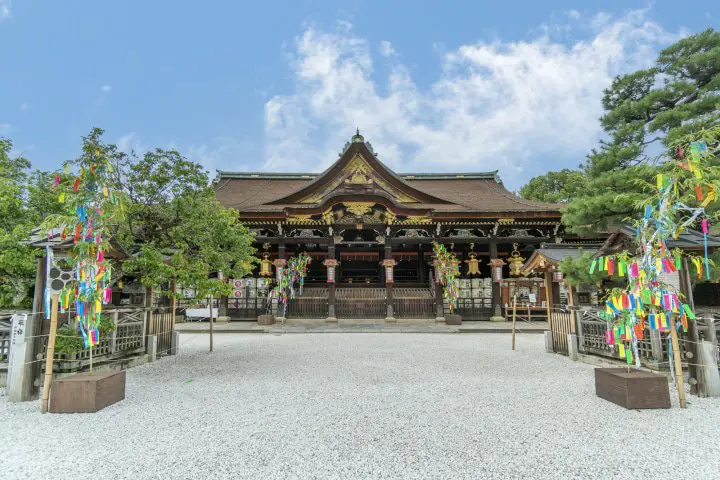
Kitano Tenmangu Shrine (Japanese) is the head shrine of 12,000 Tenmangu Shrines across Japan. Tenmangu Shrines are dedicated to Sugawara no Michizane, the deity of scholars.
The shrine was established in 947 and is visited by millions of students as a sacred place to pray for passing entrance exams and academic achievement. It’s also believed that rubbing one of the cow statues on the premises will grant you good fortune.
There are 1,500 plum trees in 50 varieties planted on the shrine premises. Baien Garden is open from early February to late March, allowing visitors to enjoy a stroll among plum blossoms in full bloom.
Kitano Tenmangu Shrine
Address: Kyoto, Kamigyo, Bakurocho
Official Website: https://kitanotenmangu.or.jp/ (Japanese)
The Shugakuin Imperial Villa Area
The Shugakuin Imperial Villa area, located a short distance from central Kyoto, is the perfect place to take in Kyoto’s rich nature.
37. Shugakuin Imperial Villa
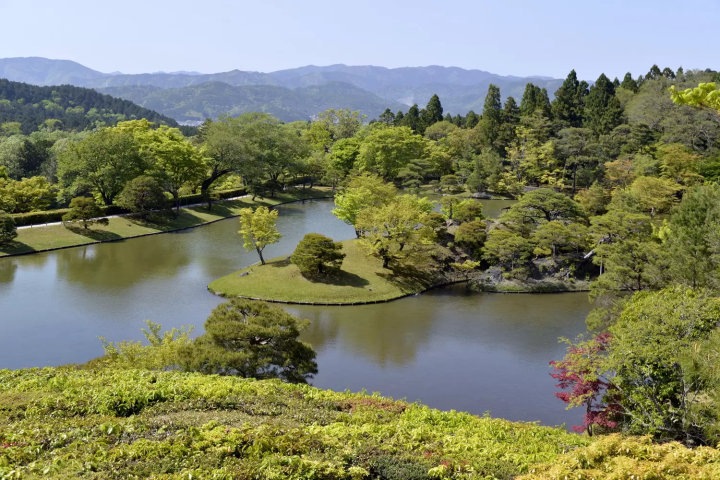
Photo by Pixta
Shugakuin Imperial Villa sits at the foot of Mt. Hiei. This mountain villa was built by Emperor Go-Mizunoo from 1656 to around 1659.
The villa grounds are divided into three areas: the Upper, Middle, and Lower Villas. In particular, the Upper Villa is great for enjoying the magnificent landscape with the surrounding mountains in the background. This is thanks to a traditional Japanese landscaping technique called shakkei (“borrowed scenery”).
Shugakuin Imperial Villa
Address: Kyoto, Sakyo, Shugakuin Yabusoe
Fee: Free *Advanced registration is required
Official Website: https://sankan.kunaicho.go.jp/multilingual/lang/en/index.html
38. Rurikoin Temple
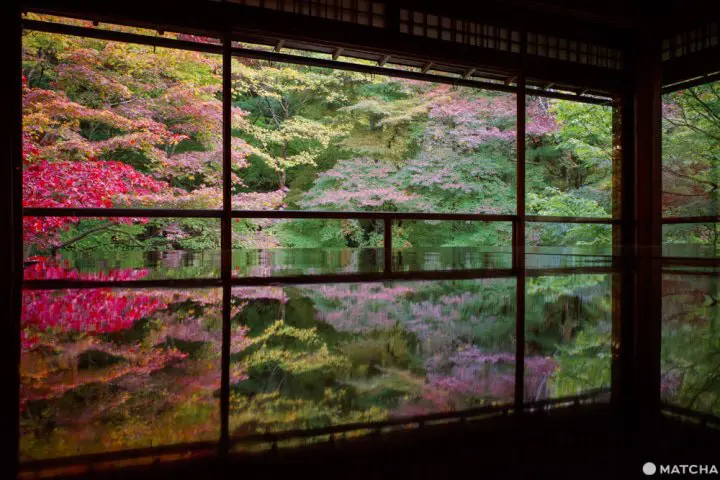
Rurikoin Temple (Japanese) is situated about two kilometers from Shugakuin Imperial Villa.
Lapis lazuli (“ruri”) is one of the seven treasures that decorate the Western Paradise of Amitabha and is considered the color of the Pure Land. The temple became known as Rurikoin because of its beautiful garden covered in maple and moss, which appears to sparkle like the azure color found in lapis lazuli.
Rurikoin Temple is especially famous for its gorgeous, reflective scenery that reflects the autumn foliage onto desks in the temple. Many temple-goers take pictures of this view.
Rurikoin Temple
Address: Kyoto, Sakyo, Kamitakano Higashiyama 55
Fee: 2,000 yen
Official Website: https://rurikoin.komyoji.com/ (Japanese)
Kyoto City Suburbs and Neighboring Regions (Byodoin Temple, etc.)
There are several sights to see in regions outside of central Kyoto and neighboring cities.
39. Byodoin Temple (Phoenix Hall)

Byodoin Temple (Phoenix Hall) in Uji is a Buddhist temple founded by Yorimichi Fujiwara in 1052.
The Phoenix Hall is said to have been constructed to emulate Amitabha’s Pure Land. It is a stunningly beautiful structure set on an island in the pond. It’s even depicted on the Japanese 10 yen coin!
Moreover, Uji is the city of tea representative of Japan. There are many cafes in Uji offering delicious matcha green tea desserts and beverages.
Byodoin Temple Ho-odo Hall (Pheonix Hall)
Address: Uji, Uji Renge 116
Fee: 600 yen
Official Website: https://www.byodoin.or.jp/en/
Purchase Uji Natural Hot Spring Genji-no-Yu Onsen Admission Tickets
40. Daigoji Temple
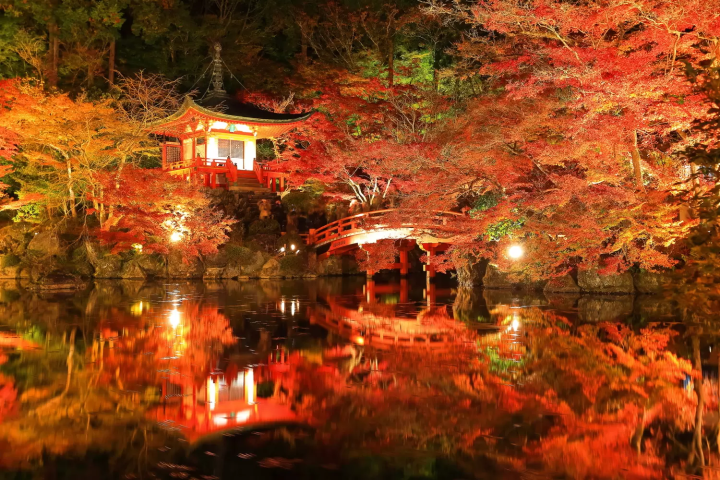
Photo by Pixta
Daigoji Temple is located in the Fushimi district of Kyoto. It is accessible in about 30 to 40 minutes by train or subway from JR Kyoto Station, then transferring to a bus.
Daigoji Temple has an extensive amount of land on Mt. Daigo. It is the famous location where Toyotomi Hideyoshi, a Sengoku military commander, held his grand hanami (flower viewing) party referred to as "Daigo Hanami," and is still known as a place for cherry blossoms today. There are also structures of interest such as the five-storied pagoda, a National Treasure, and Sanboin Temple for its connection to Toyotomi Hideyoshi.
Daigoji Temple
Address: Kyoto, Fushimi, Daigo Higashiojicho 22
Fee: 1,000 yen
Official Website: https://www.daigoji.or.jp/index_e.html
41. Kifune Shrine

Kifune Shrine in the small town of Kifune is known as a Kyoto summer retreat. Although it is located in Kyoto City, it takes about 40 minutes by car to travel to the shrine from Kyoto Station.
Kifune Shrine is where the deity of rain and water is enshrined. It’s also known as a place for matchmaking. This belief comes from the fact that Izumi Shikibu, a popular female poet from the Heian Period, visited the shrine to improve her bad relationship with her husband and composed a love poem as a result.
Kifune Shrine
Address: Kyoto, Sakyo, Kuramakibunecho 180
Official Website: https://kifunejinja.jp/en/
Kyoto Day Trips: Amanohashidate, Ine, and More!
There are several fascinating and charming spots to see throughout Kyoto Prefecture.
One particularly well-known spot is Amanohashidate, otherwise known as one of Japan’s three scenic views. However, there are plenty of spots to enjoy breathtaking bamboo-lined paths and agricultural landscapes. Why not escape from the hustle and bustle of the city and go searching for other attractions in Kyoto?
42. Amanohashidate

Photo by Pixta
Amanohashidate is a sandbar separating Miyazu Bay and the Aso Sea. It is an unparalleled landscape that was chosen as one of Japan’s three most scenic views.
Legend states that Amanohashidate was formed when Izanagi, the divine male creator of the Japanese islands, knocked down the bridge he used to descend to Earth from the heavens. The name “Amanohashidate” (“Bridge to Heaven”) likely originated because the view of the sandbar when seen upside down between one’s legs appears like a bridge erected over the heavens.
There are also several additional highlights in the area, the top being one of Japan’s leading scenic views. It takes around two hours by car from JR Kyoto Station to Amanohashidate. However, it’s a spot you must visit when in Kyoto!
Amanohashidate
Address: Miyazu, Monju, Amanohashidate Park
Official Website: https://www.amanohashidate.jp/lang/en/
Purchase Amanohashidate Kasamatsu Sightseeing 2-Day Pass
Read also
43. Ine Boathouses
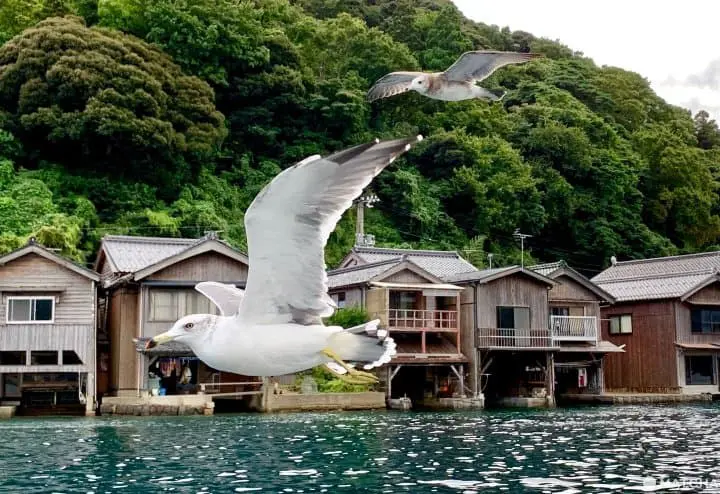
Picture from Ine, Kyoto: Beautiful Daily Life In A Scenic Seaside Town
Ine, a port town in Kyoto, is famous for funaya (boathouses) that sit along its emerald green waters.
These unique structures were originally built to protect boats from heavy wind and rain. Now, there are accommodation spaces to immerse yourself in the romantic ambiance while gazing out the windows at the tranquil sea.
In Ine, visitors can experience a sightseeing ferry, sea kayaking, or dining at restaurants sourcing local ingredients. Mukai Brewery is a popular sake brewery in the port town.
Ine Funaya
Address: Yosa, Inecho
Official Website: https://www.ine-kankou.jp/en
44. Maizuru Brick Park
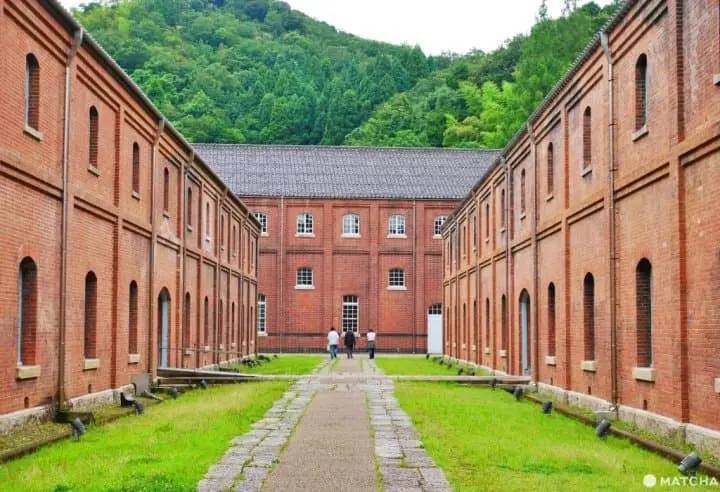
Picture from Maizuru East and West: Tour Two Sides of Kyoto’s Port City
Maizuru has prospered as a port city for many years. It is especially famous as the city that was home to Japan’s naval base between the Meiji (1868-1912) and Showa (1926-1989) periods.
Several historical landmarks still remain in the city, but one of the most well-known is Maizuru Brick Park (Japanese). The building was originally used as a warehouse for the Navy but has presently become a filming location for movies.
You’ll find the Red Brick Art Museum, conveying the charms of brick architecture, located inside the park. There’s also a cafe serving a recreation of dishes eaten by navy personnel, including curry and nikujaga (Japanese meat and potato stew).
Maizuru Brick Park
Address: Maizuru, Kitasui 1039-2
Official Website: https://akarenga-park.com/ (Japanese)
45. Kyoto Tango Railway
Picture from 6 Amazing Views! The Winner’s Of MATCHA’s Japan Photo Contest
Kyoto Tango Railway’s sightseeing trains are great for those interested in snapping gorgeous landscape photos. The trains on this railway service travel between Amanohashidate and Maizuru. You can also take photos from Yuragawa Bridge to make it look like you’re traveling on water.
You can also delight in local food on the sightseeing trains. Please check the official website for details on the trains and reservations.
46. Wazuka Town

Picture courtesy of Wazukacha Cafe
Wazuka, a town in southern Kyoto, is called “Teatopia.” It is a famous production area for Uji tea boasting 800 years of history.
Ishitera Tea Plantation, a popular destination as a picturesque spot, is located in this town. You can also enjoy food and unique drinks made with tea. Alternatively, you can try your hand at experiences related to tea like tea art and tea-picking.
Wazuka Town Ishitera Tea Plantation
Address: Soraku, Wazukacho, Ishitera Maruzuka Bushitani 82
Official Website: https://wazukanko.com/english/
47. Miyama: The Thatched Roof Houses

Picture from Idyllic Scenery and Traditional Crafts: 10 Destinations in Kyoto’s Mountainside
Miyama Kayabuki no Sato is located in the town of Miyama, just north of Kyoto City. This idyllic area is where you can interact with traditional life. Many thatched roofed homes built 150 to 220 years ago still remain and have been designated as part of the Important Preservation Districts for Groups of Traditional Buildings.
The Miyama Folklore Museum is where you can get an understanding of life in the past in this village. There are also guided tours for visitors to enjoy.
Miyama Kayabuki no Sato
Address: Nantan, Miyamachokita
Official Website: https://kayabukinosato.jp/
48. Take-no-Michi Bamboo Path

Picture from Bamboo Groves, Temples, and History! 10 Inspiring Places in Western Kyoto
Arashiyama Bamboo Grove isn’t the only place you can take amazing scenic photos of bamboo in Kyoto.
Take-no-Michi Bamboo Path, located near Hankyu Nishi-Muko Station, is accessible in about 20 minutes from JR Kyoto Station via the JR and Hankyu Lines. It is a 1.8-kilometer path surrounded by a bamboo forest. The bamboo fence built along the path enhances the natural beauty of the forest.
Located midway through Take-no-Michi is Kyoto City Rakusai Bamboo Park. At the park, you can view exhibits on traditional bamboo tools in Japan.
Take-no-Michi Bamboo Path
Address: Muko, Nishikyo, Teradocho
Official Website: https://www.muko-kankou.jp/recommend/detail.html?id=585 (Japanese)
49. Asahi Beer Oyamazaki Villa Museum of Art

Picture from Bamboo Groves, Temples, and History! 10 Inspiring Places in Western Kyoto
The Asahi Beer Oyamazaki Villa Museum of Art, opened in 1996, holds exhibitions on modern Japanese and Western art.
The main building was originally built by businessman Shotaro Kaga (1888-1954) as a villa in 1920. Both the building and garden reflect Mr. Kaga’s interests in the United Kingdom and his love of nature.
The Underground Jewelry Box, an annex displaying works by Monet and other artists, was designed by renowned architect Tadao Ando. The annex harmonizes with the surrounding nature, which deepens the beauty of the landscape.
Asahi Beer Oyamazaki Villa Museum of Art
Address: Otokuni, Oyamazakicho, Zenihara 5-3
Fee: 900 yen
Official Website: https://www.asahibeer-oyamazaki.com/english/
50. Suntory Kyoto Brewery

Picture courtesy of Suntory Holdings Limited
Suntory Kyoto Brewery, a factory of the major Japanese beer manufacturer Suntory, was established in 1969 in Nagaokakyo. This land was selected for the factory because natural water can be retrieved from this area.
You can learn about the beer-making process by participating in a factory tour. The entire process from the selection of raw ingredients to the preparation, fermentation, storage, and packaging is visible on this tour. It's likely an experience that beer enthusiasts won’t be able to resist.
Suntory Kyoto Brewery
Address: Nagaokakyo, Choshi 3-1-1
Fee: Free and paid tours are available *Reservations required for both
Official Website: https://www.suntory.co.jp/factory/kyoto/ (Japanese)
Cherry Blossoms, Fall Foliage, and Events in Kyoto
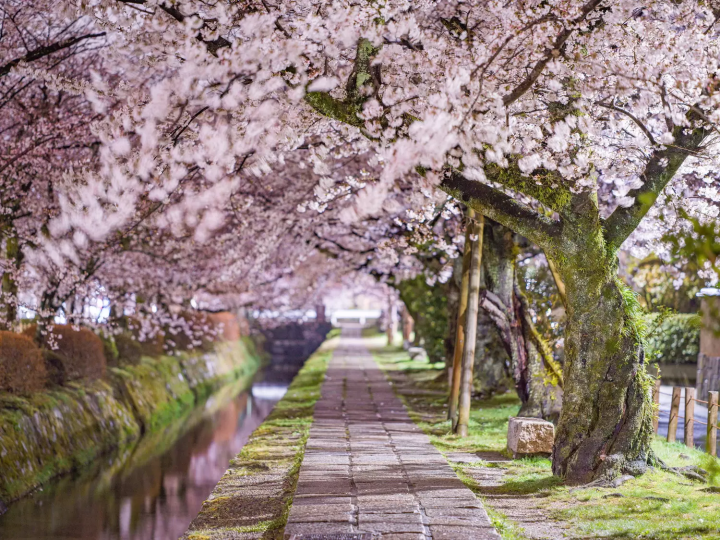
Photo by Pixta
Kyoto is a prefecture famed for cherry blossoms and autumn foliage. Please refer to the MATCHA articles below for details on what spots are especially popular.
Read also
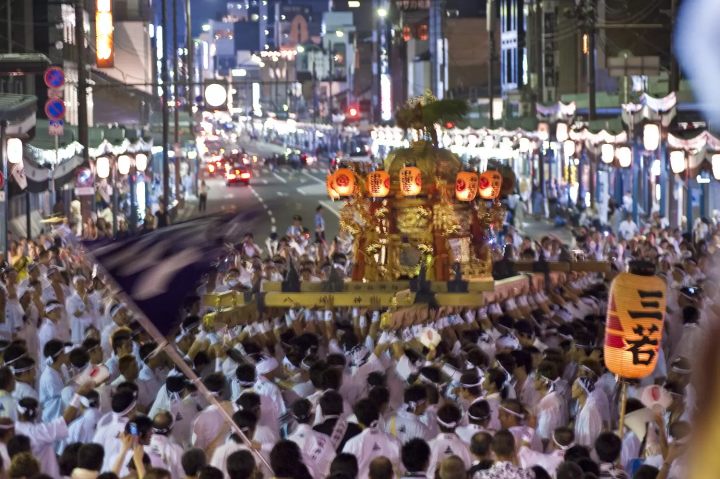
Photo by Pixta
A multitude of festivals can be enjoyed in Kyoto. Famous festivals in the prefecture include the Aoi Festival hosted by Shimogamo Shrine and Kamigamo Shrine in May, Gion Festival held by Yasaka Shrine in July, and Jidai Festival held at Heian Shrine in October.
Also held on August 16 is Gozan Okuribi, where fires are burned on mountains in the shape of giant Japanese characters to send off deceased souls to the afterlife.
Read also
Traveling to Kyoto
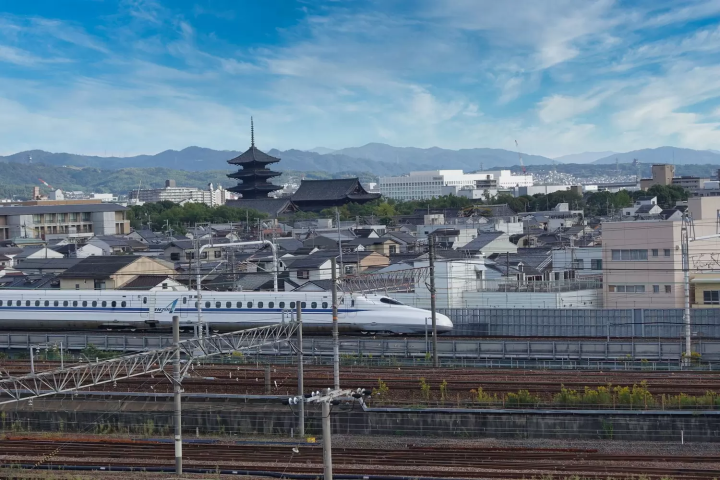
Photo by Pixta
There are various transportation methods available such as the train or Shinkansen (bullet train) at every departure station that will travel to Kyoto.
From Tokyo to Kyoto: Book the JR Pass for Whole Japan (7, 14, or 21 Days)
MATCHA has written comprehensive guides on how to access Kyoto from different departure points. Please feel free to take a look at the articles below.
Read also
Ride Passes Available for Use in Kyoto
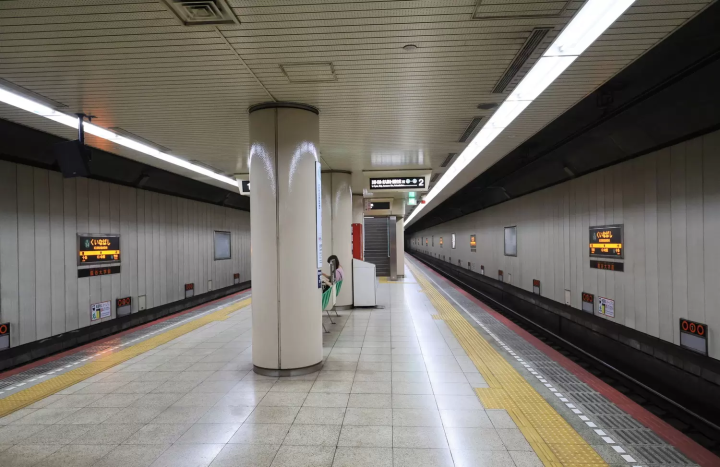
Photo by Pixta
In Kyoto, you can utilize the Subway & Bus One-Day Pass, a day pass for unlimited rides on municipal subways and buses.
International visitors also have access to a discount ride pass called the JR West Kansai Wide Area Pass, grantING unlimited rides on JR lines in the Kansai region. Please read the MATCHA article below for details on ride passes for international visitors.
Kyoto Travel Tips and Precautions
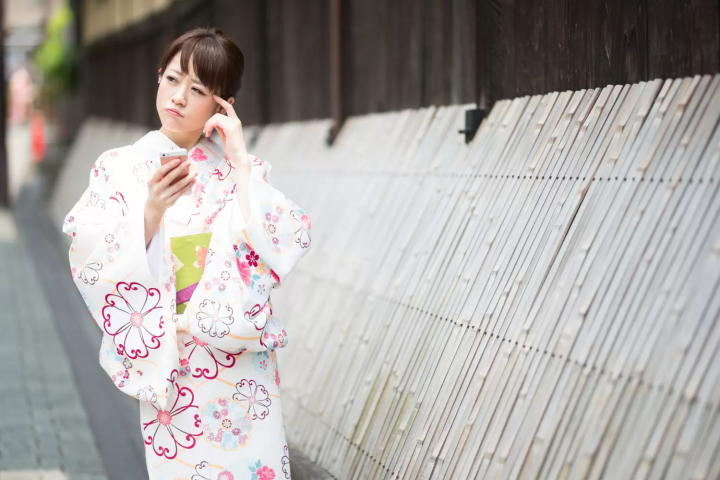
Photo by Pixta
Here are a few tips and precautions to note when traveling in Kyoto, one of the leading and most popular sightseeing destinations in the world.
Make Reservations at Hotels and Restaurants Early!
Kyoto has thousands of visitors at a time, so there’s a possibility you won’t get reservations or seats at a hotel or restaurant on the same day. Once your travel schedule is finalized, please make your hotel and restaurant reservations as soon as possible.
Book a Kyoto hotel on Booking.com!
Book a Kyoto hotel on Agoda!
Popular spots tend to be very crowded during the cherry blossom season, autumn foliage season, and consecutive Japanese holidays like Golden Week. If you are visiting during peak periods, it is best to assume that everything will take longer than usual due to crowds.
We also recommend using booking websites like Klook to purchase your tickets in advance.
Hot Summers and Cold Winters
Kyoto City is a basin surrounded by mountains in all four directions. This is why summers will be hot and muggy. On the other hand, winters are dry and reach freezing temperatures.
Bring light clothing when visiting in the summer. Also, make sure to take the proper measures against the cold in autumn and winter!
Smoking is Prohibited!
Smoking on the streets of Kyoto is usually prohibited. If you are caught smoking cigarettes outdoors while on public property (streets, parks, etc.), then you may be fined 1,000 yen in penalties.
Use Public Transportation When Possible
Kyoto City is often crowded. If you are sightseeing in central Kyoto, make sure to use public transportation such as the train, subway, or bus when possible.
Follow Proper Manners and Etiquette
Kyoto has seen situations arise in the past few years that caused inconveniences in the daily lives of locals due to the increase in tourists.
In Kyoto, the “Code of Conduct for Sustainable Tourism in Kyoto (Kyoto Tourism Etiquette)” was formulated in 2020 to create sustainable sightseeing destinations. These are reminders for visitors to “proactively interact with the local residents,” “check notices on where photography is prohibited,” and “avoid littering trash” to name a few.
Please follow the proper manners so that everyone can have a great time in Kyoto!
Reference: Code of Behavior for Tourists
You’ll Want to Repeatedly Visit Charming Kyoto
There are still many more highlights and sights in Kyoto that we couldn't introduce in this article! Visit Kyoto multiple times to dive deeper into this city's charms!
This article is an updated version of the original published on October 12, 2016.
Main image by Pixta









































































![[Gunma] 5 recommended gourmet foods at Kawaba Denen Plaza Roadside Station!](https://resources.matcha-jp.com/resize/720x2000/2025/02/26-225970.webp)
![[Kanazawa] Enjoy the world of gold leaf to the fullest in the city with the highest production volume in Japan](https://resources.matcha-jp.com/resize/720x2000/2025/11/12-249564.webp)
![[2026] Family Winter Trip to Suzuka Circuit! – For Both Day trips and Overnight Stays!](https://resources.matcha-jp.com/resize/720x2000/2025/12/26-254097.webp)

![[2026] Top 5 Strawberry Picking Spots in Tokushima, Naruto| Farms and Access Guide for January to May](https://resources.matcha-jp.com/resize/720x2000/2025/03/06-227165.webp)